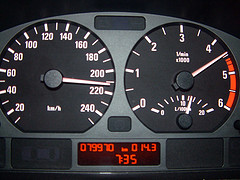At the beginning of the summer, I went to a conference at Exeter, and vowed to blog about some of the things I learned from it. Which I haven’t made good on, yet. There were a few gems, and I thought I’d write about ’em briefly in a series on mini-posts.
The first is a simple way to get kids to think about the meaning of a derivative or an integral conceptually, before they’ve formally been introduced to it. It’s a Gedankenexperiment (thought experiment) and the presenter said they actually do it on parent visitation day, so the parents can think too.
You’re in a car with three things: a speedometer, an odometer, and a clock. Everything is going along dandy, until suddenly, your speedometer breaks. Can you tell how fast you’re going? You don’t want to get pulled over by the cops, after all.
That’s it. Can you imagine how fun that conversation would be to listen to, as a proverbial teacher-fly on the wall? And then to get to lead that discussion? Obviously, most students are going to talk about the problem as if you are going at a constant speed. Getting them out of that mindset will be awesome.
Of course, the natural second question is what happens if not the speedometer, but the odometer, breaks. Can you tell how far you’ve gone?
I dig this thought experiment. I mean, it’s so simple I don’t know why I hadn’t thought of doing it to motivate our work. Heck, you can have students talk in groups and present their ideas. Good stuff.

Better find a picture without a tach…
(but yes, the exercise is great.)
Yeah… yeah…
I give a project based on similar concept in pre-calc at the end of the year. I stole it from my master teacher when I was doing student teaching and modified it a bit.
Student drive with parents or friends for 20 minutes (preferably on freeway/highway, traffic lights are not friendly to this, not sure how this will work in New York). Record the distance and speed at 20 second intervals. I had them record on a clipboard while someone else was driving. Some students figured it would be safer to take pictures using cellphone instead of asking someone to read off the values. Use a trip meter/odometer if available, if not then treat current reading as 0. Like how year 2009 is year zero on a graph.
Differential portion
Plot distance over time. Calculate slope between adjacent points (keep the units!!!). Compare with recorded values for speed (review unit conversion if necessary).
Integral portion
Plot speed over time. Use trapezoids for find the areas (keep the units!!!). Compare with recorded values for distance (review unit conversion if necessary).
What’s the connection? They use PowerPoint to present and Excel to create charts and table.
According to an article in Men’s Health, “12 percent of new gym members join in January, with some clubs seeing an increase of 30 to 50 percent.” By March, new member attendance diminishes considerably. Of the members who keep their membership year round, the average person hits the gym only 54 times a year, about once a week.